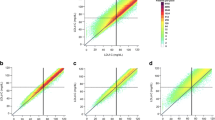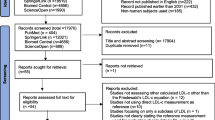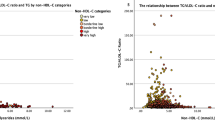Abstract
Purpose of Review
The Friedewald equation for estimation of low-density lipoprotein cholesterol (LDL-C) was published in 1972 as an alternative to direct assessment by preparative ultracentrifugation. In this equation, very low-density lipoprotein is estimated by dividing triglycerides by a fixed factor (5 in mg/dL or 2.2 in mmol/L) and subtracting this term from non-high-density lipoprotein cholesterol (non-HDL-C). This method was derived in fasting samples from a small cohort of patients with primarily genetic dyslipidemias followed at the NIH. The method served well as the global standard for LDL-C estimation for decades, but is not well suited to modern clinical practice because it tends to underestimate LDL-C at low LDL-C and high triglyceride levels. The concern is that underestimation could lead to undertreatment in high-risk patients.
Recent Findings
Derived from big data and now validated around the world, a novel LDL-C equation created at Johns Hopkins replaces the fixed factor seen in the classic equation with a patient-specific variable based on triglyceride and non-HDL-C levels.
Summary
Given its superior accuracy in fasting and non-fasting populations alike, the novel equation is now the preferred method for LDL-C estimation and is being incorporated by leading clinical laboratories.
Similar content being viewed by others
Abbreviations
- LDL-C:
-
Low-density lipoprotein cholesterol
- VLDL-C:
-
Very low-density lipoprotein cholesterol
- IDL-C:
-
Intermediate-density lipoprotein cholesterol
- HDL-C:
-
High-density lipoprotein cholesterol
- Non-HDL-C:
-
Non-high-density lipoprotein cholesterol
- PCSK9:
-
Proprotein convertase subtilisin/kexin type 9
- TG:
-
Triglycerides
- TC:
-
Total cholesterol
- NCEP:
-
National Cholesterol Education Program
- ASCVD:
-
10-year atherosclerotic cardiovascular disease
- ACC:
-
American College of Cardiology
- CTT:
-
Cholesterol Treatment Trialists
- IMPROVE-IT:
-
Improved Reduction of Outcomes: Vytorin Efficacy International Trial
- FOURIER:
-
Further Cardiovascular Outcomes Research with PCSK9 Inhibition in Subjects with Elevated Risk
References
Papers of particular interest, published recently, have been highlighted as: •• Of major importance
Friedewald WT, Levy RI, Fredrickson DS. Estimation of the concentration of low-density lipoprotein cholesterol in plasma, without use of the preparative ultracentrifuge. Clin Chem. 1972;18:499–502. https://doi.org/10.1016/0002-9149(88)90248-2.
Martin SS, Blaha MJ, Elshazly MB, Brinton EA, Toth PP, McEvoy JW, et al. Friedewald-estimated versus directly measured low-density lipoprotein cholesterol and treatment implications. J Am Coll Cardiol. 2013;62(8):732–9. https://doi.org/10.1016/j.jacc.2013.01.079.
Berry PH, Macdonald JS, Alberts AW, et al. Brain and optic system pathology in hypocholesterolemic dogs treated with a competitive inhibitor of 3-hydroxy-3-methylglutaryl coenzyme A reductase. Am J Pathol. 1988;132(3):427–43.
Neaton JD, Blackburn H, Jacobs D, Kuller L, Lee DJ, Sherwin R, et al. Serum cholesterol level and mortality findings for men screened in the multiple risk factor intervention trial. Multiple Risk Factor Intervention Trial Research Group. Arch Intern Med. 1992;152(7):1490–500. https://doi.org/10.1001/archinte.152.7.1490.
Wiviott SD, Cannon CP, Morrow DA, Ray KK, Pfeffer MA, Braunwald E, et al. Can low-density lipoprotein be too low? The safety and efficacy of achieving very low low-density lipoprotein with intensive statin therapy: a PROVE IT-TIMI 22 substudy. J Am Coll Cardiol. 2005;46(8):1411–6. https://doi.org/10.1016/j.jacc.2005.04.064.
Scharnagl H, Nauck M, Wieland H, Marz W. The Friedewald formula underestimates LDL cholesterol at low concentrations. Clin Chem Lab Med. 2001;39:426–31. https://doi.org/10.1515/cclm.2001.068.
Sabatine MS, Giugliano RP, Keech AC, Honarpour N, Wiviott SD, Murphy SA, et al. Evolocumab and clinical outcomes in patients with cardiovascular disease. N Engl J Med. 2017 May 4;376(18):1713–22. https://doi.org/10.1056/nejmoa1615664.
Stone NJ, Robinson JG, Lichtenstein AH, Bairey Merz CN, Blum CB, Eckel RH, et al. 2013 ACC/AHA guideline on the treatment of blood cholesterol to reduce atherosclerotic cardiovascular risk in adults. J Am Coll Cardiol. 2014;63(25):2889–934. https://doi.org/10.1016/j.jacc.2013.11.002.
Robinson JG, Farnier M, Krempf M, Bergeron J, Luc G, Averna M, et al. Efficacy and safety of alirocumab in reducing lipids and cardiovascular events. N Engl J Med. 2015;372(16):1489–99. https://doi.org/10.1056/nejmoa1501031.
Baigent C, Keech A, Kearney PM, et al. Efficacy and safety of cholesterol-lowering treatment: prospective meta-analysis of data from 90,056 participants in 14 randomised trials of statins. Lancet. 2005;366(9493):1267–78. https://doi.org/10.1016/s0140-6736(05)67394-1.
Martin SS, Blumenthal RS, Miller M. LDL cholesterol: the lower the better. Med Clin North Am. 2012;96(1):13–26. https://doi.org/10.1016/j.mcna.2012.01.009.
Sabatine MS, Wiviott SD, Im K, Murphy SA, Giugliano RP. Efficacy and safety of further lowering of low-density lipoprotein cholesterol in patients starting with very low levels: a meta-analysis. JAMA Cardiol. 2018; https://doi.org/10.1001/jamacardio.2018.2258.
Zulewski H, Ninnis R, Miserez AR, Baumstark MW, Keller U. VLDL and IDL apolipoprotein B-100 kinetics in familial hypercholesterolemia due to impaired LDL receptor function or to defective apolipoprotein B-100. J Lipid Res. 1998;39(2):380–7. https://doi.org/10.1016/0021-9150(95)96509-q.
Brown WV, Levy RI, Fredrickson DS. Studies of the proteins in human plasma very low density lipoproteins. J Biol Chem. 1969;244(20):5687–94.
Gibbons GF, Islam K, Pease RJ. Mobilisation of triacylglycerol stores. Biochim Biophys Acta. 2000;1483(1):37–57. https://doi.org/10.1016/s1388-1981(99)00182-1.
Olefsky J, Reaven GM, Farquhar JW. Effects of weight reduction on obesity. Studies of lipid and carbohydrate metabolism in normal and hyperlipoproteinemic subjects. J Clin Invest. 1974;53(1):64–76. https://doi.org/10.1172/jci107560.
Kissebah AH, Alfarsi S, Adams PW. Integrated regulation of very low density lipoprotein triglyceride and apolipoprotein-B kinetics in man: normolipemic subjects, familial hypertriglyceridemia and familial combined hyperlipidemia. Metab Clin Exp. 1981;30(9):856–68. https://doi.org/10.1016/0026-0495(81)90064-0.
Vergès BL. Dyslipidaemia in diabetes mellitus. Review of the main lipoprotein abnormalities and their consequences on the development of atherogenesis. Diabetes Metab. 1999;25(Suppl 3):32–40.
Quispe R, Hendrani A, Elshazly MB, Michos ED, McEvoy JW, Blaha MJ, et al. Accuracy of low-density lipoprotein cholesterol estimation at very low levels. BMC Med. 2017;15(1):83. https://doi.org/10.1186/s12916-017-0852-2.
Catapano AL, Graham I, De Backer G, et al. 2016 ESC/EAS guidelines for the management of dyslipidaemias. Eur Heart J. 2016;37:2999–3058. https://doi.org/10.1093/eurheartj/ehw272.
Anderson TJ, Gregoire J, Pearson GJ, et al. 2016 Canadian Cardiovascular Society guidelines for the management of dyslipidemia for the prevention of cardiovascular disease in the adult. Can J Cardiol. 2016;32:1263–82. https://doi.org/10.1016/j.cjca.2016.07.510.
Jacobson TA, Ito MK, Maki KC, Orringer CE, Bays HE, Jones PH, et al. National lipid association recommendations for patient-centered management of dyslipidemia: part 1--full report. J Clin Lipidol. 2015;9:129–69. https://doi.org/10.1016/j.jacl.2015.02.003.
Cannon CP, Blazing MA, Giugliano RP, et al. Ezetimibe added to statin therapy after acute coronary syndromes. N Engl J Med. 2015;372(25):2387–97. https://doi.org/10.1056/NEJMoa1410489.
Murphy SA, Cannon CP, Blazing MA, Giugliano RP, White JA, Lokhnygina Y, et al. Reduction in total cardiovascular events with ezetimibe/simvastatin post-acute coronary syndrome the IMPROVE-IT trial. J Am Coll Cardiol. 2016;67(4):353–61. https://doi.org/10.1016/j.jacc.2015.10.077.
Nordestgaard BG, Langsted A, Mora S, Kolovou G, Baum H, Bruckert E, et al. Fasting is not routinely required for determination of a lipid profile: clinical and laboratory implications including flagging at desirable concentration cut-points-a joint consensus statement from the European Atherosclerosis Society and European Federation of Clinical Chemistry and Laboratory Medicine. Eur Heart J. 2016;37(25):1944–58. https://doi.org/10.1373/clinchem.2016.258897.
Langsted A, Freiberg JJ, Nordestgaard BG. Fasting and nonfasting lipid levels: influence of normal food intake on lipids, lipoproteins, apolipoproteins, and cardiovascular risk prediction. Circulation. 2008;118:2047–56. https://doi.org/10.1161/circulationaha.108.804146.
Ruge T, Svensson M, Eriksson JW, Olivecrona G. Tissue-specific regulation of lipoprotein lipase in humans: effects of fasting. Eur J Clin Investig. 2005;35:194–200. https://doi.org/10.1111/j.1365-2362.2005.01470.x.
Ladu MJ, Kapsas H, Palmer WK. Regulation of lipoprotein lipase in adipose and muscle tissues during fasting. Am J Phys. 1991;260:R953–9. https://doi.org/10.1152/ajpregu.1991.260.5.r953.
Mora S. Nonfasting for routine lipid testing: from evidence to action. JAMA Intern Med. 2016;176(7):1005–6. https://doi.org/10.1001/jamainternmed.2016.1979.
Mora S, Rifai N, Buring JE, Ridker PM. Fasting compared with nonfasting lipids and apolipoproteins for predicting incident cardiovascular events. Circulation. 2008;118:993–1001. https://doi.org/10.1161/circulationaha.108.777334.
Ridker PM, Rifai N, Cook NR, Bradwin G, Buring JE. Non-HDL cholesterol, apolipoproteins A-I and B100, standard lipid measures, lipid ratios, and CRP as risk factors for cardiovascular disease in women. JAMA. 2005;294:326–33. https://doi.org/10.1001/jama.294.3.326.
Nordestgaard BG, Benn M, Schnohr P, Tybjaerg-Hansen A. Nonfasting triglycerides and risk of myocardial infarction, ischemic heart disease, and death in men and women. JAMA. 2007;298:299–308. https://doi.org/10.1001/jama.298.3.299.
Bansal S, Buring JE, Rifai N, Mora S, Sacks FM, Ridker PM. Fasting compared with nonfasting triglycerides and risk of cardiovascular events in women. JAMA. 2007;298:309–16. https://doi.org/10.1001/jama.298.3.309.
van Deventer HE, Miller WG, Myers GL, Sakurabayashi I, Bachmann LM, Caudill SP, et al. Non-HDL cholesterol shows improved accuracy for cardiovascular risk score classification compared to direct or calculated LDL cholesterol in a dyslipidemic population. Clin Chem. 2011;57:490–501. https://doi.org/10.1373/clinchem.2010.154773.
Nordestgaard BG. A test in context: lipid profile, fasting versus nonfasting. J Am Coll Cardiol. 2017;70:1637–46. https://doi.org/10.1016/j.jacc.2017.08.006.
Driver SL, Martin SS, Gluckman TJ, Clary JM, Blumenthal RS, Stone NJ. Fasting or nonfasting lipid measurements: it depends on the question. J Am Coll Cardiol. 2016;67:1227–34. https://doi.org/10.1016/j.jacc.2015.12.047.
Sathiyakumar V, Park J, Golozar A, Lazo M, Quispe R, Guallar E, et al. Fasting versus nonfasting and low-density lipoprotein cholesterol accuracy. Circulation. 2018;137:10–9. https://doi.org/10.1161/circulationaha.117.030677.
Winocour PH, Ishola M, Durrington PN. Validation of the Friedewald formula for the measurement of low density lipoprotein cholesterol in insulin-dependent diabetes mellitus. Clin Chim Acta. 1989;179(1):79–83. https://doi.org/10.1016/0009-8981(89)90025-9.
Warnick GR, Knopp RH, Fitzpatrick V, Branson L. Estimating low-density lipoprotein cholesterol by the Friedewald equation is adequate for classifying patients on the basis of nationally recommended cutpoints. Clin Chem. 1990;36(1):15–9.
Tremblay AJ, Morrissette H, Gagné JM, Bergeron J, Gagné C, Couture P. Validation of the Friedewald formula for the determination of low-density lipoprotein cholesterol compared with beta-quantification in a large population. Clin Biochem. 2004;37(9):785–90. https://doi.org/10.1016/j.clinbiochem.2004.03.008.
Knopfholz J, Disserol CC, Pierin AJ, et al. Validation of the Friedewald formula in patients with metabolic syndrome. Cholesterol. 2014;2014:261878. https://doi.org/10.1155/2014/261878.
DeLong DM, DeLong ER, Wood PD, Lippel K, Rifkind BM. A comparison of methods for the estimation of plasma low- and very low-density lipoprotein cholesterol: the lipid research clinics prevalence study. JAMA. 1986;256(17):2372–7. https://doi.org/10.1001/jama.1986.03380170088024.
Rim JH, Lee YH, Lee MH, Kim HY, Choi J, Lee BW, et al. Comparison and validation of 10 equations including a novel method for estimation of LDL-cholesterol in a 168,212 Asian population. Medicine (Baltimore). 2016;95(14):e3230. https://doi.org/10.1097/md.0000000000003230.
Rao A, Parker AH, El-sheroni NA, Babelly MM. Calculation of low-density lipoprotein cholesterol with use of triglyceride/cholesterol ratios in lipoproteins compared with other calculation methods. Clin Chem. 1988;34(12):2532–4.
McNamara JR, Cohn JS, Wilson PWF, Schaefer E. Calculated values for low-density lipoprotein cholesterol in the assessment of lipid abnormalities and coronary disease risk. Clin Chem. 1990;36:36–42.
Hattori Y, Suzuki M, Tsushima M, Yoshida M, Tokunaga Y, Wang Y, et al. Development of approximate formula for LDL-chol, LDL-apo B and LDL-chol/LDL-apo B as indices of hyperapobetalipoproteinemia and small dense LDL. Atherosclerosis. 1998;138(2):289–99. https://doi.org/10.1016/s0021-9150(98)00034-3.
Martins J, Olorunju SA, Murray LM, Pillay TS. Comparison of equations for the calculation of LDL-cholesterol in hospitalized patients. Clin Chim Acta. 2015;444:137–42. https://doi.org/10.1016/j.cca.2015.01.037.
Anandaraja S, Narang R, Godeswar R, Laksmy R, Talwar KK. Low-density lipoprotein cholesterol estimation by a new formula in Indian population. Int J Cardiol. 2005;102(1):117–20. https://doi.org/10.1016/j.ijcard.2004.05.009.
Krishnaveni P, Gowda VM. Assessing the validity of Friedewald’s formula and Anandraja’s formula for serum LDL-cholesterol calculation. J Clin Diagn Res. 2015;9(12):BC01–4. https://doi.org/10.7860/jcdr/2015/16850.6870.
Teerakanchana T, Puavilai W, Suriyaprom K, Tungtrongchitr R. Comparative study of LDL-cholesterol levels in Thai patients by the direct method and using the Friedewald formula. Southeast Asian J Trop Med Public Health. 2007;38(3):519–27.
Osegbe I, Ugonabo M, Chukwuka C, Meka I, Nwosu N. Comparison of calculated versus directly-measured low-density lipoprotein-cholesterol: an evaluation of ten formulas for an HIV-positive population in sub-Saharan Africa. J Lab Physicians. 2017;9(2):111–5. https://doi.org/10.4103/0974-2727.199632.
Ahmadi SA, Boroumand MA, Gohari-moghaddam K, Tajik P, Dibaj SM. The impact of low serum triglyceride on LDL-cholesterol estimation. Arch Iran Med. 2008;11(3):318–21.
Chen Y, Zhang X, Pan B, Jin X, Yao H, Chen B, et al. A modified formula for calculating low-density lipoprotein cholesterol values. Lipids Health Dis. 2010;9:52. https://doi.org/10.1186/1476-511x-9-52.
Vujovic A, Kotur-stevuljevic J, Spasic S, et al. Evaluation of different formulas for LDL-C calculation. Lipids Health Dis. 2010;9:27.
Choi H, Shim JS, Lee MH, Yoon YM, Choi DP, Kim HC. Comparison of formulas for calculating low-density lipoprotein cholesterol in general population and high-risk patients with cardiovascular disease. Korean Circ J. 2016;46(5):688–98. https://doi.org/10.4070/kcj.2016.46.5.688.
Wadhwa N, Krishnaswamy R. Comparison of LDL-cholesterol estimate using various formulae with directly measured LDL-cholesterol in Indian population. J Clin Diagn Res. 2016;10(12):BC11–3. https://doi.org/10.7860/jcdr/2016/22272.9018.
De cordova CM, De cordova MM. A new accurate, simple formula for LDL-cholesterol estimation based on directly measured blood lipids from a large cohort. Ann Clin Biochem. 2013;50(Pt 1):13–9. https://doi.org/10.1258/acb.2012.011259.
•• Martin SS, Blaha MJ, Elshazly MB, et al. Comparison of a novel method vs the Friedewald equation for estimating low-density lipoprotein cholesterol levels from the standard lipid profile. JAMA. 2013;310:2061–8. https://doi.org/10.1001/jama.2013.280532. Initial study to propose the Martin LDL-C equation, which is currently being incorporated globally as the new standard of LDL-C estimation.
Chaen H, Kinchiku S, Miyata M, Kajiya S, Uenomachi H, Yuasa T, et al. Validity of a novel method for estimation of low-density lipoprotein cholesterol levels in diabetic patients. J Atheroscler Thromb. 2016;23(12):1355–64. https://doi.org/10.5551/jat.35972.
Lee J, Jang S, Son H. Validation of the Martin method for estimating low-density lipoprotein cholesterol levels in Korean adults: findings from the Korea National Health and Nutrition Examination Survey, 2009-2011. PLoS One. 2016;11(1):e0148147. https://doi.org/10.1371/journal.pone.0148147.
Mehta R, Reyes-rodríguez E, Yaxmehen Bello-chavolla O, et al. Performance of LDL-C calculated with Martin's formula compared to the Friedewald equation in familial combined hyperlipidemia. Atherosclerosis. 2018; https://doi.org/10.1016/j.atherosclerosis.2018.06.868.
Kang M, Kim J, Lee SY, Kim K, Yoon J, Ki H. Martin’s equation as the most suitable method for estimation of low-density lipoprotein cholesterol levels in Korean adults. Korean J Fam Med. 2017;38(5):263–9. https://doi.org/10.4082/kjfm.2017.38.5.263.
Bachorik P. Measurement of low-density-lipoprotein cholesterol. In: Rifai N, Warnick G, Dominiczak M, editors. Handbook of lipoprotein testing, 2nd ed. Washington D.C: AACC Press; 2000. p. 245.
Miller WG, Myers GL, Sakurabayashi I, Bachmann LM, Caudill SP, Dziekonski A, et al. Seven direct methods for measuring HDL and LDL cholesterol compared with ultracentrifugation reference measurement procedures. Clin Chem. 2010;56:977–86. https://doi.org/10.1373/clinchem.2009.142810.
Whelton SP, Meeusen JW, Donatp LJ, et al. Evaluating the atherogenic burden of individuals with a Friedewald-estimated low-density lipoprotein cholesterol < 70 mg/dL compared with a novel low-density lipoprotein estimation method. J Clin Lipidol. 2017;11(4):1065–72. https://doi.org/10.1016/j.jacl.2017.05.005.
Martin S, Giugliano R, Murphy S, et al. Martin/Hopkins estimation, Friedewald and beta-quantification of LDL-C in patients in FOURIER. J Clin Lipidol. 2018;12(2):565–6. https://doi.org/10.1016/j.jacl.2018.03.071.
Sathiyakumar V, Park J, Quispe R, Elshazly MB, Michos ED, Banach M, et al. Impact of novel LDL-C assessment on the utility of secondary non-HDL-C and ApoB targets in selected worldwide dyslipidemia guidelines. Circulation. 2018;138:244–54. https://doi.org/10.1161/circulationaha.117.032463.
Meeusen JW, Lueke AJ, Jaffe AS, Saenger AK. Validation of a proposed novel equation for estimating LDL cholesterol. Clin Chem. 2014;60(12):1519–23. https://doi.org/10.1373/clinchem.2014.227710.
Author information
Authors and Affiliations
Corresponding author
Ethics declarations
Conflict of Interest
SSM and SRJ have patent applications pending on the novel equation for LDL-C estimation. In addition, SSM reports personal fees for serving on scientific advisory boards for Amgen, Sanofi/Regeneron, Quest Diagnostics, and Akcea Therapeutics, as well as grants/research support from the PJ Schafer Cardiovascular Research Fund, the David and June Trone Family Foundation, American Heart Association, Aetna Foundation, Maryland Innovation Initiative, Nokia, Google, Apple, and iHealth.
Authors VP, RQ, ME, RV, and VS have no conflicts of interest to disclose.
Human and Animal Rights and Informed Consent
This article does not contain any studies with human or animal subjects performed by any of the authors.
Additional information
This article is part of Topical Collection on Lipids
Rights and permissions
About this article
Cite this article
Pallazola, V.A., Quispe, R., Elshazly, M.B. et al. Time to Make a Change: Assessing LDL-C Accurately in the Era of Modern Pharmacotherapeutics and Precision Medicine. Curr Cardiovasc Risk Rep 12, 26 (2018). https://doi.org/10.1007/s12170-018-0590-9
Published:
DOI: https://doi.org/10.1007/s12170-018-0590-9




